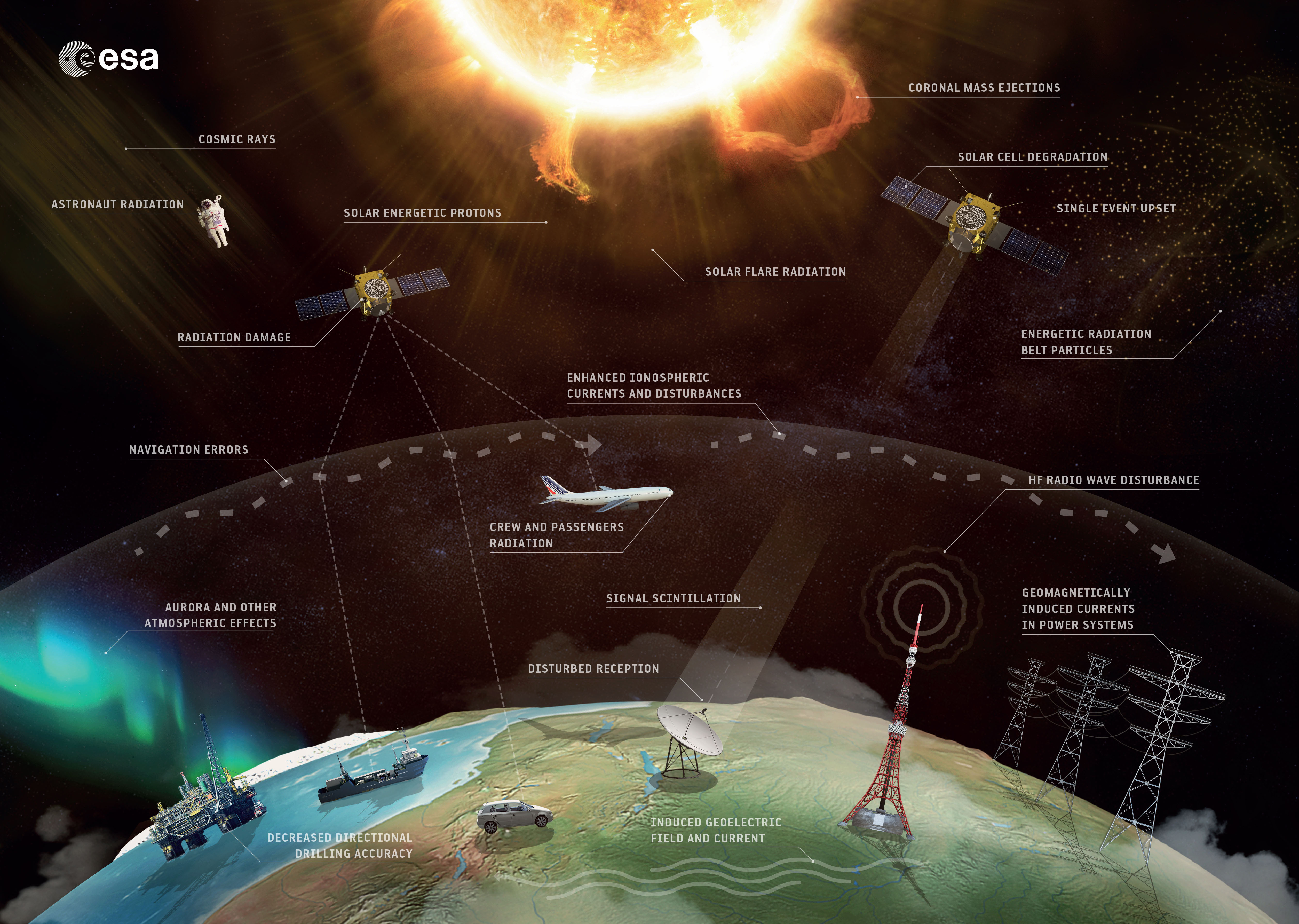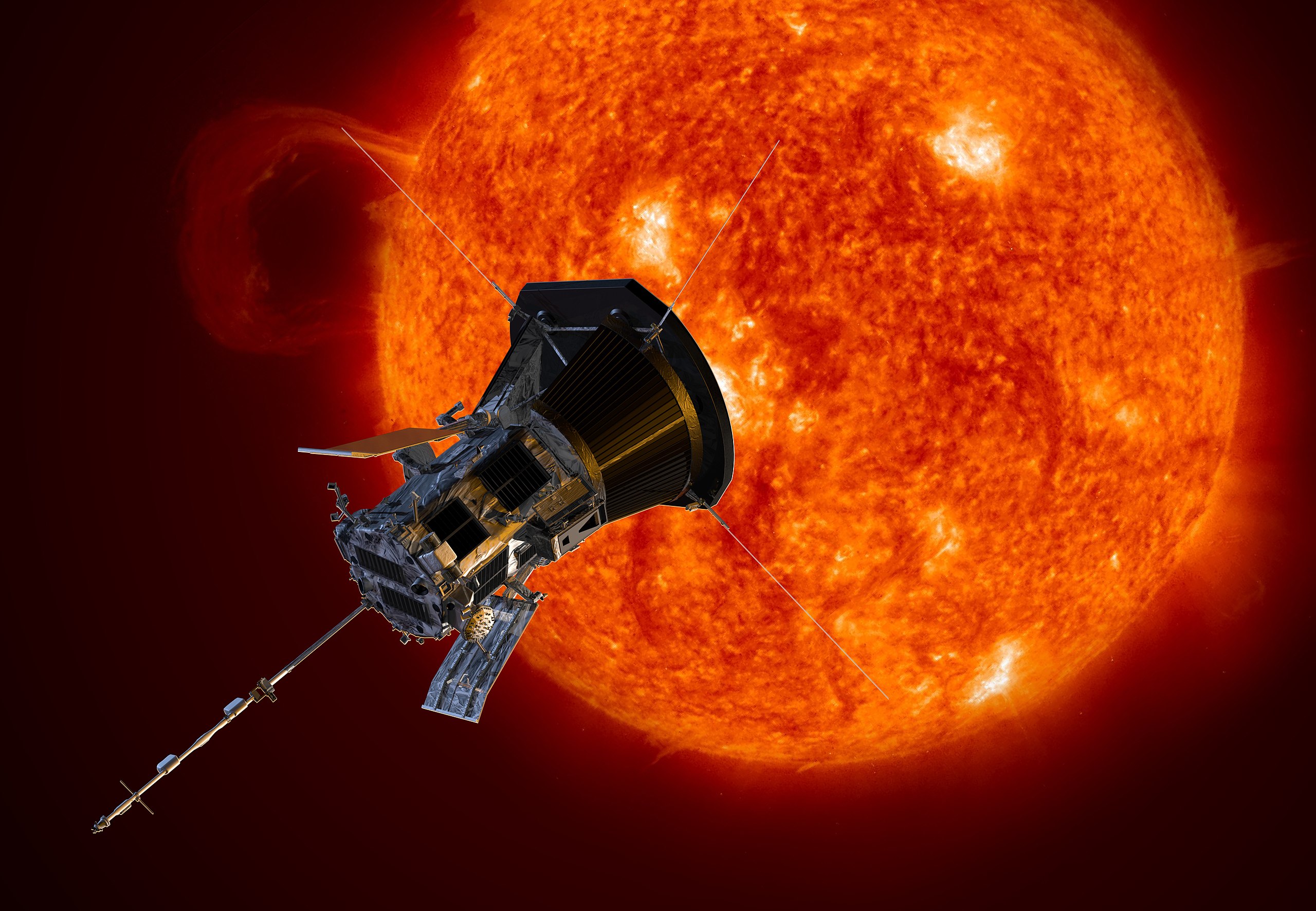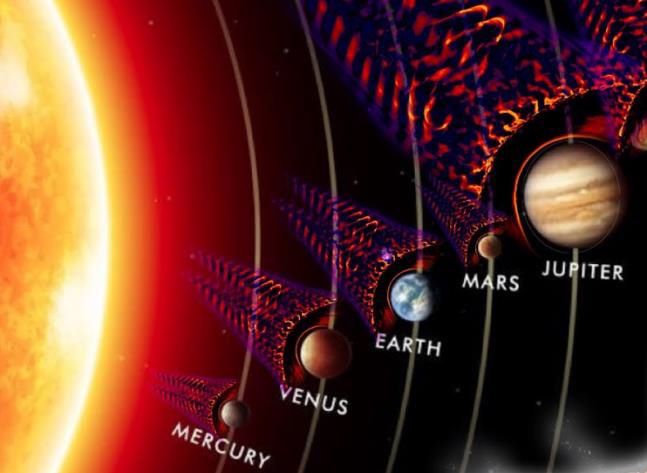PhD Studentship Opportunities
- Each year we have positions available for PhD study in the group. These are funded by various sources such as STFC, QMUL, CSC, DISCnet, but we also welcome applications from students with their own funding.
- The PhD program takes 3-4 years, involving a specialised project in one of our research areas. The QMUL Doctoral College offers comprehensive training courses and support throughout the program.
- See below and the webpages of David Burgess, Enrico Camporeale, Christopher Chen, or Heli Hietala for available projects and please get in touch with the relevant advisor(s) if you are interested.
- See here for details of the application process, including the relevant deadlines (usually in January each year).
- The School of Physics and Astronomy runs an open day for prospective PhD students, usually in December. See the school's PhD Pages for the latest info, including FAQ about PhD study at Queen Mary.
Sample Projects:
 Space Weather Processes. Image credit: ESA.
Machine Learning for Space Plasma and Space Weather Applications
Space Weather Processes. Image credit: ESA.
Machine Learning for Space Plasma and Space Weather ApplicationsPrimary Supervisor: Dr Enrico Camporeale
Extended application deadline: 30 April 2024
Space weather refers to the changing plasma conditions in near-Earth space that can have a range of impacts on our modern society. The solar wind is highly structured, and when this meets the Earth’s magnetic field, disturbances can lead to a chain of events that have an impact on our technology infrastructure, including power grid blackouts, satellite damage and increased risk of satellite collisions, increased radiation on polar flights. None of these events can be reliably forecast at the moment and our group is actively working on developing machine learning-based forecasting models. A related area of research that can be addressed in this project is the problem of sub-grid closure in collisionless plasma modeling, that is the inability of large-scale simulations to consistently capture small-scale (kinetic) features. Promising results have been shown in the context of neutral fluid turbulence, and we are actively investigating the use of machine learning to tackle this problem in space plasmas. The applicant should have a strong background in machine learning algorithms and software (phyton libraries) and be familiar with space plasmas and/or space weather phenomenology. The project will be supervised by Dr. Enrico Camporeale. Eligibility: The normal minimum entry requirement is an upper second class honours degree in Physics, Astronomy or Astrophysics, Mathematics, or in a subject with substantial physics and/or mathematics content. Please note that only UK home students are eligible for this scholarship.
 The Parker Solar Probe spacecraft. Image credit: NASA.
Space Plasma Turbulence Throughout the Solar System and Beyond
The Parker Solar Probe spacecraft. Image credit: NASA.
Space Plasma Turbulence Throughout the Solar System and BeyondPrimary Supervisor: Dr Christopher Chen
The vast majority of the visible Universe is in a plasma state, and one of the most widespread behaviours observed in such plasmas is turbulence – the transfer of energy across a broad range of scales that leads to complex chaotic motions, structure formation, and energy conversion. Not only is this turbulence a fascinating area of fundamental plasma physics, it is thought to be important in a variety of important open questions in space and astrophysics, such as the heating of the solar corona, generation of the solar wind, structure of the heliosphere, acceleration of energetic particles, disk physics, galaxy cluster heating, and space weather. Within the solar system, spacecraft make direct in situ measurements, allowing the physics of turbulence, e.g., in the solar wind, to be probed and understood in great detail, which has been very fruitful in advancing our understanding, along with theory and simulations. However, due to its complexity, there remain many important questions about how it works at a fundamental level, and contributes to the processes that shape the space and astrophysical environments. This project involves the analysis of data from the latest cutting-edge space missions, to learn more about how turbulence works in newly explored regions of space and contributes to shaping the space environment. For example, NASA Parker Solar Probe is moving ever closer to the Sun, making the first measurements within the solar corona where the turbulence powers the solar wind, but is fundamentally different to further out. The NASA Voyager spacecraft are newly exploring the interstellar medium, where again turbulence is found to be different in nature, allowing us to understand how this shapes our heliosphere and galactic processes. You will work as part of a team at QMUL studying the fundamentals and impacts of plasma turbulence, and have the opportunity to work with international experts in space missions, data analysis, plasma theory, simulations, and laboratory plasma astrophysics experiments.
 Shocks across the solar system.
Structure of shock waves across the Solar System
Shocks across the solar system.
Structure of shock waves across the Solar SystemPrimary Supervisor: Dr Heli Hietala
Shock waves are seen throughout the universe and the closest one is the Earth’s bow shock, standing in the solar wind upstream of our magnetosphere. Similar shock waves form ahead of other planets in our solar system, as well as coronal mass ejections from the Sun, stars, supernovae, and other astrophysical objects. Shock waves are one of the main accelerators of high energy particles in space. We can study the shocks in our own solar system in detail with instruments onboard scientific spacecraft that directly measure the electromagnetic fields and particles as they fly through the shocks. Naturally, the most comprehensive observations are of the Earth’s bow shock. In this project, you will use these near-Earth datasets, spanning decades of variable solar wind conditions, to make comparisons with measurements from other Solar System environments. You will investigate fundamental physical processes that lead to formation of structures and acceleration of particles. These have applications to both remote astrophysical objects and to forecasting solar energetic particle events hazardous to our modern society. During the project you will learn to analyse and visualize large datasets. You will develop new data-analysis tools in preparation for future space missions such as HelioSWARM (expected launch 2028). There is also an option to enhance the project with numerical simulations. You will be supported by colleagues both at QMUL and across the world. The project follows from the activities of an international team that I am leading. You can check out its website at: https://www.issibern.ch/teams/heliosysspec/.
 A supernova remnant with shock wave. Image credit: NASA.
Particle Acceleration in Shocks and Turbulence in Astrophysics
A supernova remnant with shock wave. Image credit: NASA.
Particle Acceleration in Shocks and Turbulence in AstrophysicsPrimary Supervisor: Dr David Burgess
Energetic particles are a ubiquitous feature of many astrophysical systems. Cosmic rays permeate the universe and are thought to be accelerated mainly at the shocks driven by supernova remnants. Shocks are formed in the intra-galactic medium during mergers of galaxy clusters. In these collisions, synchrotron radiation from electrons with relativistic energies show as some of the largest observable coherent features on the radio sky. Nearer to home, shocks observed in the solar wind are always associated with accelerated and nonthermal particles. There are still many puzzles about the processes leading to particle acceleration. In particular, the interplay between shocks and turbulence is increasingly recognized to be important. This project will use a combination of spacecraft observations and computer simulations to advance our understanding of particle acceleration in astrophysics. In particular, large-scale plasma simulations will be used to make comparisons with data from shocks in space plasmas. These results will then be used in an astrophysical context to determine the basic processes at work in, for example, solar flares and galaxy cluster mergers.